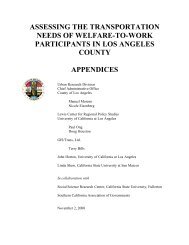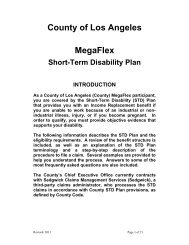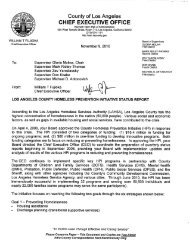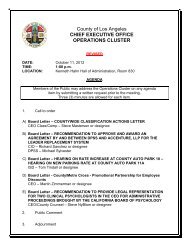Prevention and Early Intervention (PEI) Plan - Chief Executive Office ...
Prevention and Early Intervention (PEI) Plan - Chief Executive Office ...
Prevention and Early Intervention (PEI) Plan - Chief Executive Office ...
Create successful ePaper yourself
Turn your PDF publications into a flip-book with our unique Google optimized e-Paper software.
Interested in participating in future <strong>PEI</strong> meetings?<br />
If you would like to be contacted to participate in future planning activities for the Los Angeles County <strong>Prevention</strong> <strong>and</strong><br />
<strong>Early</strong> <strong>Intervention</strong> <strong>Plan</strong>, please complete this form on the other side, tear off the form, <strong>and</strong> mail it to the address below:<br />
County of Los Angeles Department of Mental Health<br />
Program Support Bureau<br />
Mental Health Services Act (MHSA)<br />
<strong>Prevention</strong> <strong>and</strong> <strong>Early</strong> <strong>Intervention</strong> (<strong>PEI</strong>) Administration<br />
550 S. Vermont Avenue, 6th Floor, Room 605<br />
Los Angeles, CA 90020<br />
*You may also e-mail the information to mhsapei@dmh.lacounty.gov<br />
Community Involvement<br />
in <strong>PEI</strong> <strong>Plan</strong>ning<br />
Q. Who should get involved in developing the<br />
<strong>PEI</strong> plan?<br />
Anyone who has an interest in mental<br />
health services. People who care about<br />
how mental health prevention <strong>and</strong> early<br />
intervention services will be delivered in Los<br />
Angeles County.<br />
Q. How can I get involved in <strong>PEI</strong> planning in the<br />
Service Areas?<br />
Participate in your local mental health<br />
Service Area Advisory Committees (SAACs).<br />
Contact the DMH Service Area District <strong>Chief</strong><br />
for meeting schedules, check the DMH<br />
website www.dmh.lacounty.gov or e-mail<br />
mhsapei@dmh.lacounty.gov<br />
Q. What are other opportunities to provide<br />
input to the <strong>PEI</strong> <strong>Plan</strong>?<br />
Individuals may be invited to participate in<br />
key informant interviews <strong>and</strong> focus groups,<br />
which will occur in early 2008. Community<br />
forums, where participants will be asked to<br />
select specific <strong>PEI</strong> strategies for their<br />
Service Areas, will be held starting in spring<br />
2008.<br />
Q. How do I get information about getting<br />
involved?<br />
Email mhsapei@dmh.lacounty.gov or call<br />
(213) 738-2331 to receive information<br />
about upcoming community events <strong>and</strong><br />
participation in planning for <strong>PEI</strong> programs.<br />
Q. What if I don’t underst<strong>and</strong> some of the<br />
terms used in this booklet or want to learn<br />
more about <strong>PEI</strong>?<br />
<strong>PEI</strong> guidelines, resource documents, <strong>and</strong> a<br />
glossary are available on the State DMH<br />
website: http://www.dmh.ca.gov/Prop_63/<br />
MHSA/<strong>Prevention</strong>_<strong>and</strong>_<strong>Early</strong>_<strong>Intervention</strong>/<br />
default.asp<br />
LOS ANGELES COUNTY<br />
BOARD OF SUPERVISORS<br />
Gloria Molina<br />
First District<br />
Yvonne B. Burke<br />
Second District<br />
Zev Yaroslavsky<br />
Third District<br />
Don Knabe<br />
Fourth District<br />
Michael D. Antonovich<br />
Fifth District<br />
William T Fujioka<br />
<strong>Chief</strong> <strong>Executive</strong> <strong>Office</strong>r<br />
County of Los Angeles<br />
Department of Mental Health<br />
Program Support Bureau<br />
Mental Health Services Act (MHSA)<br />
<strong>Prevention</strong> <strong>and</strong> <strong>Early</strong> <strong>Intervention</strong> (<strong>PEI</strong>)<br />
Administration<br />
550 S. Vermont Avenue, Ste. 605<br />
Los Angeles, CA 90020<br />
Phone: (213) 738-2331<br />
Fax: (213) 351-2026<br />
E-mail: mhsapei@dmh.lacounty.gov<br />
Website: www.dmh.lacounty.gov<br />
LOS ANGELES COUNTY<br />
DEPARTMENT OF<br />
MENTAL HEALTH<br />
MENTAL HEALTH<br />
SERVICES ACT (MHSA)<br />
<strong>Prevention</strong> <strong>and</strong><br />
<strong>Early</strong> <strong>Intervention</strong><br />
(<strong>PEI</strong>) <strong>Plan</strong><br />
Director Marvin J. Southard, D.S.W.
The Los Angeles County Department of<br />
Mental Health (DMH) is undertaking an<br />
intensive, inclusive, <strong>and</strong> multi-faceted<br />
approach to developing the County’s<br />
<strong>Prevention</strong> <strong>and</strong> <strong>Early</strong> <strong>Intervention</strong> (<strong>PEI</strong>)<br />
<strong>Plan</strong>, one of five plans authorized by the<br />
Mental Health Services Act (MHSA)<br />
enacted by California voters in 2004.<br />
<strong>Prevention</strong> in mental health involves<br />
reducing risk factors or stressors, building<br />
protective factors <strong>and</strong> skills, <strong>and</strong><br />
increasing support. <strong>Prevention</strong> promotes<br />
positive cognitive, social <strong>and</strong> emotional<br />
development <strong>and</strong> encourages a state of<br />
well-being that allows the individual to<br />
function well in the face of changing <strong>and</strong><br />
sometimes challenging circumstances.<br />
<strong>Early</strong> <strong>Intervention</strong> is directed toward<br />
individuals <strong>and</strong> families for whom a short<br />
duration (usually less than one year) <strong>and</strong><br />
relatively low-intensity intervention is<br />
appropriate to measurably improve a<br />
mental health problem or concern very<br />
early in its manifestation, thereby<br />
avoiding the need for more extensive<br />
mental health treatment or services; or<br />
preventing a mental health problem from<br />
getting worse.<br />
Service Area Approach. The focus for<br />
developing the L.A. County <strong>PEI</strong> <strong>Plan</strong> is at<br />
the Service Area level—utilizing<br />
informational meetings, key informant<br />
interviews, focus groups, <strong>and</strong> community<br />
forums. Service Area profiles identifying<br />
socio-economic demographic data <strong>and</strong><br />
mental health statistics, as well as data<br />
related to health, education, social<br />
services, <strong>and</strong> public safety will be<br />
developed to aid the planning process.<br />
The State Department of Mental Health (SDMH)<br />
has targeted 5 community mental health needs,<br />
6 priority populations, <strong>and</strong> 6 statewide efforts<br />
for the <strong>Prevention</strong> <strong>and</strong> <strong>Early</strong> <strong>Intervention</strong><br />
program:<br />
Key Community Mental Health Needs<br />
• Disparities in Access to Mental Health<br />
Services<br />
• Psycho-Social Impact of Trauma<br />
• At-Risk Children, Youth <strong>and</strong> Young Adult<br />
Populations<br />
• Stigma <strong>and</strong> Discrimination<br />
• Suicide Risk<br />
Priority Populations<br />
• Underserved Cultural Populations<br />
• Individuals Experiencing Onset of Serious<br />
Psychiatric Illness<br />
• Children/Youth in Stressed Families<br />
• Trauma-Exposed<br />
• Children/Youth at Risk for School Failure<br />
• Children/Youth at Risk of or Experiencing<br />
Juvenile Justice Involvement<br />
State-Administered Projects<br />
• Suicide <strong>Prevention</strong><br />
• Stigma <strong>and</strong> Discrimination Reduction<br />
• Ethnically <strong>and</strong> Culturally Specific Programs<br />
<strong>and</strong> <strong>Intervention</strong>s<br />
• Training, Technical Assistance <strong>and</strong> Capacity<br />
Building<br />
• Student Mental Health Initiative<br />
• Statewide Evaluation<br />
<strong>Prevention</strong><br />
CSS<br />
Treatment & Recovery<br />
Sector Partnerships. SDMH has identified 7<br />
sectors that counties must partner with to<br />
develop their <strong>PEI</strong> <strong>Plan</strong>. Community partnerships<br />
<strong>and</strong> resource leveraging are required with:<br />
► Underserved Communities<br />
► Education<br />
► Individuals with Serious Mental Illness<br />
<strong>and</strong>/or Their Families<br />
► Providers of Mental Health Services<br />
► Health<br />
► Social Services<br />
► Law Enforcement<br />
SDMH also recommended additional sectors,<br />
including community family resource centers,<br />
employment, <strong>and</strong> media.<br />
Funding. The following chart lists the<br />
estimated funding amounts for Los Angeles<br />
County from 2007-2009.<br />
FISCAL YEAR<br />
2007‐2008<br />
LA COUNTY DMH<br />
<strong>PEI</strong> ESTIMATED FUNDING<br />
$34,001,800 *<br />
2008‐2009 $57,161,000<br />
*includes $7,074,500 million in planning funds<br />
TOTAL: $91,162,800<br />
A minimum of 51% of the overall County <strong>PEI</strong> <strong>Plan</strong><br />
budget must be dedicated to the child (ages 0-<br />
15) <strong>and</strong> transition-age youth (TAY ages 16-25)<br />
populations.<br />
_____ Please send me information on future <strong>PEI</strong> meetings. ____ I would be willing to participate in a focus group for <strong>PEI</strong> planning.<br />
Name:<br />
Organization:<br />
Position/Title:<br />
Address:<br />
City, State, Zip Code:<br />
Email:<br />
Phone:<br />
Please check the category or sector that is most applicable to you:<br />
_____ Mental Health Consumer _____ Health _____ Education<br />
_____ Family Member/Parent of Mental Health Consumer _____ Social Services _____ Law Enforcement<br />
_____ Mental Health Provider _____ Employment _____ Media<br />
_____ Faith-Based Organization _____ Community Member _____ Other Government Agency<br />
_____ Other
















